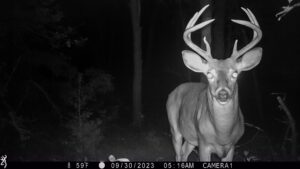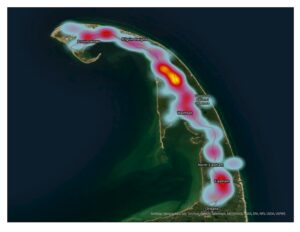November is a risky time to be a deer on the Outer Cape. Besides that it’s bow-and-arrow hunting season, collisions between deer and cars are most frequent in this month.

Based on data collected by our four local police depts. over the last nine years and analyzed by the Independent, of 217 vehicle collisions with deer, 46 occurred in November — that’s with the numbers for this fall not yet available.
The high rate of vehicle-deer collisions in the late fall can be attributed to a combination of deer and human factors, according to Martin Feehan, Deer & Moose Project leader with the Mass. Div. of Fisheries and Wildlife.
In an email to the Independent, Feehan said that the reproductive period for deer, known as their rut, stretches from mid-October to mid-December, with November being the peak. During this time, male deer have more testosterone and therefore are moving around a lot more than usual to find females, which in turn are on the move trying to get away from bucks.
This high testosterone period for deer coincides with shorter days and the switch to standard time, changes that place the evening peak of human workday traffic shortly after sunset — exactly when the daily peak of deer activity tends to be.
The collisions are not evenly distributed. The Independent used the police data to identify our local deer collision hotspots. Most collisions occur on Route 6, with some stretches of the highway standing out as more dangerous than others. The top stretch for collisions was in Truro, between North Pamet and South Highland roads. Over the nine years in the data review, 39 collisions happened there — more than one every four months. This stretch accounted for 17 percent of all deer collisions in the four Outer Cape towns.
There were three other collision hotspots along Route 6: one between Governor Prence Road and Nauset Road in Eastham; another between Long Pond Road and Gull Pond Road in Wellfleet; and a third between Conwell Street and Snail Road in Provincetown.

These hotspots are in areas where good deer habitat is near the road, and all but one is near a wetland — the Pamet and Little Pamet Rivers, the Herring River, and Nauset Marsh all abut deer collision hotspots.
According to Amy Villamagna, professor of interdisciplinary studies at Plymouth State University in New Hampshire, who has studied the causes of collisions between vehicles and wildlife, it is difficult to determine why more collisions may happen at any particular spot. That’s because a variety of factors, including visibility, habitat proximity, and level of development, can influence both driver and animal behavior.
Villamagna said that deer tend to feed better in shrubby, deciduous-dominated areas than coniferous forests, which have taller trees and less leafy understories. On Cape Cod, shrubby, deciduous-dominated habitat tends to be more prevalent in lowlands near sources of fresh water. Wetlands often offer better preserved habitat, since development is difficult on and near them, and waterways also serve as natural corridors along which wildlife can travel, she said.
She also noted that collisions tend to be more common in areas where animals are used to cars — something she said is true of the deer on Cape Cod’s narrow geography.
Deer collisions are not just dangerous for deer. A 2022 study led by then-University of Washington ecology postdoctoral fellow Calum Cunningham found that deer collisions cause about 440 deaths and 59,000 injuries and result in more than $10 billion in economic losses nationwide every year.
Villamagna doesn’t think deer crossing signs work. “People have become so desensitized to their presence that they don’t slow down,” she said. She thinks signs activated during particularly collision-prone times of the year might be more effective.
Driver awareness and alertness matter, according to Villamagna, and are needed to prevent vehicle-deer collisions. She is one of the co-authors of a report that identified collision hotspots for the New Hampshire Dept. of Transportation with one perhaps counterintuitive finding: a high proportion of these accidents occurred not on curves but on straight stretches of road. That’s where drivers feel most at ease and least alert, she said.



